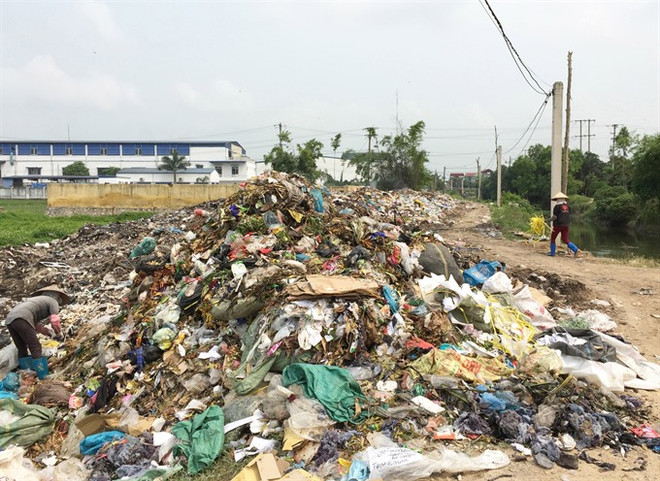 Rubbish piles up on the side of a road next to a paddy field in the Tien Lu district of Hung Yen province. (Photo: VNA)
Rubbish piles up on the side of a road next to a paddy field in the Tien Lu district of Hung Yen province. (Photo: VNA)Hanoi (VNA) - Domestic waste management and treatment hasbeen a pressing issue for rural areas in Vietnam for many years.
In suburban Chuong My district in Hanoi, tonnes of waste have been discarded onthe sides of roads, forming huge mounds of stinking rubbish, Thanh Nien (YoungPeople) newspaper reported.
“Plastic bags full of rotting trash pile up and spread onto the road, but it israrely taken away," said Le Thi Hien, owner of a beauty boutique near adump in Ngọc Hoa commune.
“The smell of decomposing meat is the worst,” said Nguyen Thi Hong. “Fliesfollow the smell, invading our houses and creating a risk of disease.”
Residents of Sai Son commune are struggling to cope with untreated domesticwaste. Many have installed glass and net doors to keep out flies and smells -and most have installed insect traps and burn incense, said resident Phung ThiKhanh.
“A dose of mosquito spray that should be effective for three months lasts onlya few days here,” she said. “Sometimes we have to hang mosquito nets around uswhen having dinner, and never dare leave the doors and windows open.”
Untreated domestic waste is also polluting agricultural land, ponds and riversin the northern province of Vinh Phuc, and robbing local farmers of theirlivelihoods.
Pham Thi Sinh, a resident of the Doai village, said she had to stop growingvegetable and peanuts a few years ago because her field was polluted by wastefrom an adjacent landfill.
“Water in a local well that we used to use to grow our plants became dark andemitted a stinking smell,” she said. “Maggots, worms and insects came out ofthe landfill every time it rained. It scared people off, and they boycotted ouragricultural products."
It is beyond the capability of authorities to treat all domestic waste, said TrinhDuy Hoa, Vice Chairman of the People’s Committee of Ngoc Hoa commune in Hanoi.
“The amount is just overwhelming,” he said. “We also tried to take the garbageout of the canals to clear water for agricultural production once in a while,but still can’t get rid of it all.”
Pham Manh Cuong, deputy manager of the environmental protection division ofVinh Phuc province, said that the province was only able to treat 400 out of585 tonnes of domestic waste every day, either by burning or burying.
Sometimes resident burn waste themselves, which creates air pollution, saidNguyen Van Thang, Vice Chairman of the People’s Committee of Chan Hung communein Vinh Phuc province.
“We are well aware of those risks, but can’t provide residents with anyalternative solution since we don’t have the resources to build high-capacityincinerators,” he said.
A 2014 report on dioxin contamination in the Vietnamese environment issued bythe Ministry of Environment and Natural Resources shows that several samples ofemission fumes and waste taken from incinerators in Hanoi, Ho Chi Minh City andthe northern province of Hai Duong have dioxin concentrations and dioxin-liketoxicities many times higher than the permitted levels.
There are about 100 low-capacity incinerators across the country that are notequipped with emission treatment systems, according to the Department of WasteManagement and Environmental Improvement. They use low temperatures for burningwaste, which leads to toxic gases being expelled into the air.
Nguyen Thanh Yen, deputy director of the department,told Thanh Nien that rural domestic waste could not be eradicated because ofthe overlapping management by different authorities.
“The responsibility for solid waste management is divided between the Ministryfor Natural Resources and Environment, the Ministry of Science and Technology,and the Ministry of Agriculture and Rural Development, but none of theseagencies has really stepped up to the mark,” he said.
“At the local level, local authorities are passive in planning waste treatmentpolicies and preparing financial resources for waste treatment,” he added.
As for the State, it has not had a specific orientation towards any wastetreatment methods and has not developed criteria for waste treatment facilityand technology selection, he added.
To improve waste treatment in rural areas, Yen said that the environmentministry would collaborate with other management agencies and local authoritiesto develop a solid waste treatment mechanism which reduces the amount of buriedwaste and promotes waste recycling, waste re-use, and energy recovery fromwaste.
The ministry will review rural environmental protection policies, and redefinethe roles of each management agency, enterprise and community in wastemanagement, he said. -VNA




























